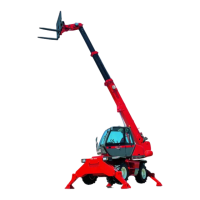2
7
MHT 10120 L M
Series
D
D
E
E
S
S
C
C
R
R
I
I
P
P
T
T
I
I
O
O
N
N
1
1 - Driver’s seat
2
2 - Seat belt
3
3 - Monitoring instrument and indicator light panel
4
4 - Load status control and safety device
5
5 - Switch console
6
6 - Light, horn and direction indicator lever
7
7 - Key-switch
8
8 - Casing giving access to brake fluid tank and windscreen-washing liquid
9
9 - Brake fluid tank
1
1
0
0 - Windscreen-washing liquid tank
1
1
1
1 - Accelerator pedal, service brake and inching pedal
1
1
2
2 - Direction reverser lever
1
1
3
3 - Parking brake lever
1
1
4
4 - Heating controls
1
1
5
5 - Ventilation outlets
1
1
6
6 - Hydraulic movement controls
1
1
7
7
- Optional exclusion switch
1
1
8
8 - Red emergency button
1
1
9
9 - Bubble level
2
2
0
0 - Levelling device
2
2
1
1
- Ceiling light
2
2
2
2 - Door lock
2
2
3
3 - Rear window opening lever
2
2
4
4 - Upper half door lock
2
2
5
5 - Towbar
2
2
6
6 - Front lights
2
2
7
7 - Rear lights
2
2
8
8 - Revolving flashing light
2
2
9
9 - Steering wheel adjuster lever
3
3
0
0 - Key to switch off the safety device
3
3
1
1 - Air conditioning (optional)
USEFUL ADVICE
Regardless of the operator’s experience in this sector, he must learn the position and
function of all instruments and controls on board before putting the fork-lift truck into operation.
When the ignition key is turned without starting the engine, a test is automatically performed on the instrumen-
tation: all the lights come on and a beeper sounds. All this stops once the engine has started.
A check must be made on all the truck’s instruments immediately after start-up once the engine has warmed
up and at regular intervals during use, so that any malfunctions can be noted at once and put right without
delay. If the instrument is not giving a correct reading, stop the engine and take the necessary measures to
restore correct operation immediately.
Using the fork-lift truck without following these recommendations may have dangerous consequences.

